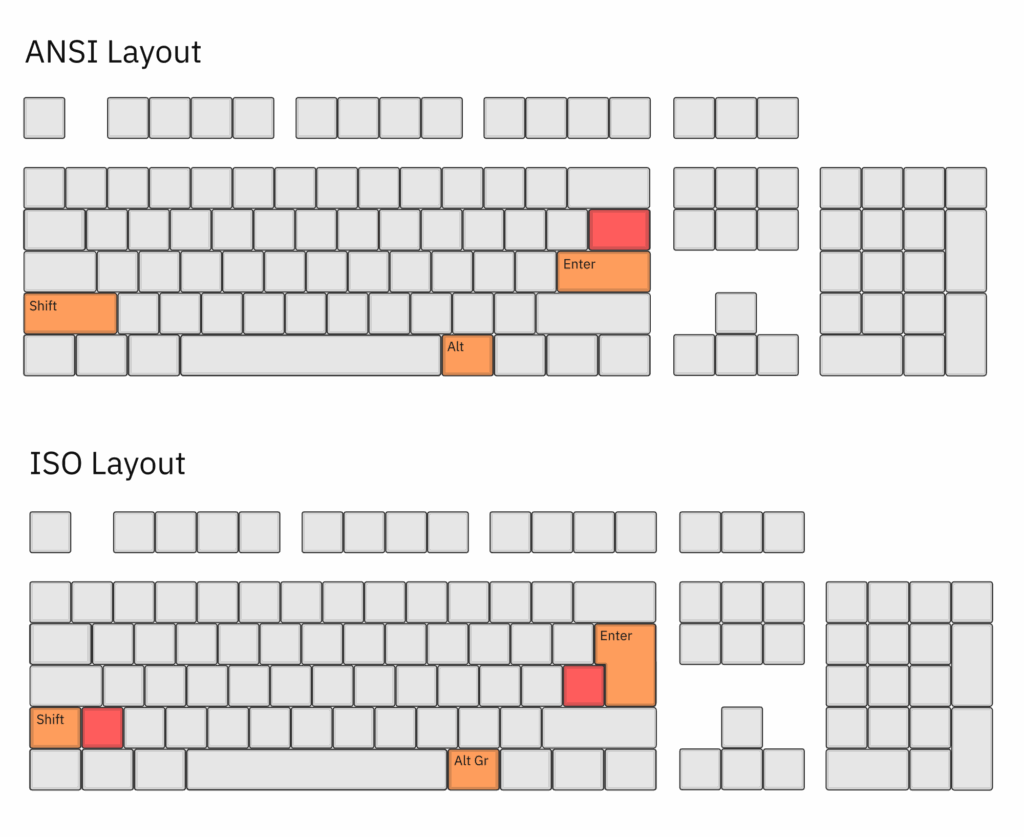ANSI and ISO layouts are two common keyboard standards. While ANSI is primarily used in North America, ISO layout keyboards are more common in European countries. In this article, you’ll learn the differences between the two layouts and how to choose the right one for you.
ANSI vs ISO layout - Differences
Differences between ANSI and ISO
The two keyboard layouts are named after the organizations behind the standards: ANSI is the abbreviation for the American National Standards Institute, and ISO is the abbreviation for the International Organization for Standardization.
Although both layouts are broadly similar, there are differences in the size and arrangement of certain keys. The most noticeable change concerns the Enter key: in the ANSI layout, it is simply slightly wider than other keys, whereas in the ISO layout, it has a unique shape (like a wide, upside-down “L”) and stretches across two rows. Furthermore, the left Shift key is shorter in the ISO layout, making room for an additional key. Another small difference exists with the Alt keys: while in the ANSI layout, both Alt keys perform the same function, the ISO layout introduces an “Alt Gr” key to enable quick access to special characters.
| ANSI Layout | ISO Layout | |
|---|---|---|
| Common in | North America and others | Europe, South America |
| Enter key | Wide | Large (spanning 2 rows) |
| Shift key (left) | Wide | Short (like Ctrl) |
| Number of keys | 104 (Full-Size) | 105 (Full-Size) |
| Backslash | Above the Enter key | Depends on the region |
| Alt keys | Left and right Alt keys are identical | Left is Alt, right is Alt Gr |
| Keycaps | Large selection | Limited selection |

Making the right choice between ANSI and ISO
Choosing a particular layout should depend on your personal requirements and how you intend to use the keyboard. Let’s take a look at the most important factors that play a role in this decision.
Keycap Compatibility
Anyone who likes to swap out keycaps and order custom sets is undoubtedly better off with ANSI. The market for keycap sets is heavily influenced by ANSI, as this standard is predominant internationally – especially in the US and Asia. For this reason, many keycap manufacturers design their products primarily for ANSI layouts. Although there are custom sets for the ISO layout, I strongly recommended to check compatibility early on and search specifically for any desired sets when purchasing the keyboard.
Comfort and Ergonomics
ANSI offers a longer left Shift key, which can be very convenient for capital letters and certain keyboard shortcut combinations, as the little finger doesn’t have to be moved quite as far to the left. In games where the Shift key is used frequently, the ANSI layout can therefore also feel more comfortable. ISO, on the other hand, scores with a large Enter key that can be easily located and recognized even without looking.
Special Characters / Multilingualism
With its higher number of keys and the presence of the “Alt Gr” key, the ISO layout offers more options for conveniently placing language-specific characters. The comfort of the larger Shift key in ANSI is quickly offset if you constantly have to strain your fingers to type diacritic or accented characters that are frequently needed. ISO is particularly well-advised for those who may need to switch back and forth between multiple languages.
Habit and Adaptation
Your typing habits are one of the most important factors when choosing a layout. If you have been using an ISO layout for years and it is ingrained in your muscle memory, switching to ANSI will feel unfamiliar, at least initially. In particular, the changed Enter key may lead to typing errors at first. The reverse is also true: ANSI users who suddenly work with ISO will have to adjust to the extra key to the right of Shift and adapt their finger positioning accordingly. In the long term, however, the change is usually not a problem – many users report that they had already adapted to the new layout just a few weeks after switching.
Layout for Programming
For programmers and IT professionals, the keyboard is a daily work tool. Here, even small details can make a big difference. When writing programs and configurations, special characters are often needed, such as various types of brackets (round, square, curly, or angle), slash, backslash, exclamation mark, or question mark. Many programmers therefore prefer English-language layouts, as many of these characters are more easily accessible there. Whether ANSI or ISO, however, plays only a minor role – in both ANSI and the UK ISO standard, most of these characters are easy to reach. In ANSI, the backslash and pipe symbol are located directly above the Enter key, making them convenient to use, while ISO offers useful special characters on the additional keys instead.
Conclusion
ANSI and ISO differ in a few but crucial details. ANSI offers more variety in keycap sets and is more widely used internationally, while ISO is the standard in Europe and can offer advantages thanks to its additional key. Ultimately, habit and intended use are the key factors in choosing a layout.


